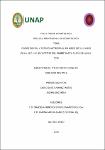Caries dental y estado nutricional en niños de 3 a 5 años de la I.E.C.J nº 168 “Gotitas del Saber” Santa Clara de Nanay, 2023
Abstract
OBJECTIVE: The present study sought to determine the association between dental caries and nutritional status in children aged 3 to 5 years from the I.E.C.J No. 168 “Gotitas del Saber” Santa Clara de Nanay, 2023. METHOD: A quantitative investigation was developed. Non-experimental, transversal and correlational design. Made up of 163 minors, criteria established by the National Center for Food and Nutrition (CENAN) were used to determine nutritional status, in relation to weight for height, weight for age, height for age, in addition to the ceo-d index established by the World Health Organization to determine the level of dental caries. RESULTS: In relation to dental caries, of 163 (100%) minors evaluated, the sample represents approximate percentages. (female; 53% and male 47%), the ages were represented in similar percentages: 3 years (31.3%), 4 years (39.3) and 5 years (29.4). Regarding the level of dental caries: 52.8% of the sample had a very high ceo-d; followed by high with 23.9%; moderate with 14.1% and low with 9.2%; According to weight for height, 74.8% had a normal weight for height; 10.4% were obese; 9.2% were overweight and 5.5% were malnourished; According to size for age, 86.5% had a size for normal weight; 11.7% were sick; 1.8% were discharged; According to weight for age, 74.8% had a normal weight for height; 10.4% were obese; 8.6% were overweight and 6.1% were malnourished. The average age was 3.98 years. The average number of brushing times per day was 2.10. The average number of decayed teeth was 4.69 per patient. The average number of teeth extracted was 0.45. The average number of teeth filled was 1.38. CONCLUSION: There is no relationship between ceo-d and nutritional status (p=0.962). But if there is a relationship between the weight and height of the sample (p=0.002); However, there is no relationship between ceo-d and sex (p=0.254). Likewise, there is no relationship between ceo-d and the variables: weight for height (p=0.909); height for age (p=0.203); weight for age (p=0.962). However, a relationship was found between ceo-d and the number of brushing times per day (p=0.000); determining the relationship in decayed, extracted and filled teeth. Demonstrating that 89.6% of the sample says they brush twice a day. OBJETIVO: El presente estudio buscó determinar la asociación entre la caries dental y estado nutricional en niños de 3 a 5 años de la I.E.C.J Nº 168 “Gotitas del Saber” Santa Clara de Nanay, 2023. MÉTODO: Se desarrolló una investigación de tipo cuantitativo. De diseño no experimental, transversal y correlacional. Conformado por 163 menores, se usó criterios establecidos por el Centro Nacional de Alimentación y Nutrición (CENAN) para determinar el estado nutricional, en relación a peso para talla, peso para edad, talla para edad, además del índice ceo-d establecido por la Organización Mundial de la Salud para determinar el nivel de caries dental. RESULTADOS: En relación a la caries dental, de 163 (100%) menores evaluados, la muestra representa aproximados porcentajes. (femenino; 53% y masculino 47%), las edades estuvieron representadas en similares porcentajes :3 años (31.3%), 4 años (39.3) y 5 años (29.4). Con respecto al nivel de caries dental: El 52,8% de la muestra tuvo un ceo-d muy alto; seguido por alto con el 23,9%; moderado con el 14,1% y bajo con el 9,2%; Según el peso para talla el 74,8% tuvo un peso para la talla normal; el 10,4% tuvo obesidad; el 9,2% tuvo sobrepeso y el 5,5% tuvo desnutrición; Según talla para edad el 86,5% tuvo una talla para el peso normal; el 11,7% tuvo baja; el 1,8% tuvo alta; Según peso para edad el 74,8% tuvo un peso para la talla normal; el 10,4% tuvo obesidad; el 8,6% tuvo sobrepeso y el 6,1% tuvo desnutrición. El promedio de edad fue 3.98 años. El promedio de número de veces de cepillado al día fue 2,10. La media de dientes cariados fue 4,69 por paciente. El promedio de dientes extraídos fue 0,45. El promedio de dientes obturados fue 1,38. CONCLUSIÓN: No existe relación entre el ceo-d y el estado nutricional (p=0.962). Pero si existe relación entre el peso y la talla de la muestra (p=0.002); Sin embargo, no existe relación entre el ceo-d y el sexo(p=0.254). Así también no existe relación entre el ceo-d y las variables: peso para talla (p=0.909); talla para edad (p=0.203); peso para edad (p=0.962). No obstante, se encontró relación entre el ceo-d y el número de veces de cepillado al día (p=0.000); determinando la relación en los dientes cariados, extraídos y obturados. Demostrando que 89,6% de la muestra dice cepillarse dos veces por día.
Collections
- Tesis [188]


